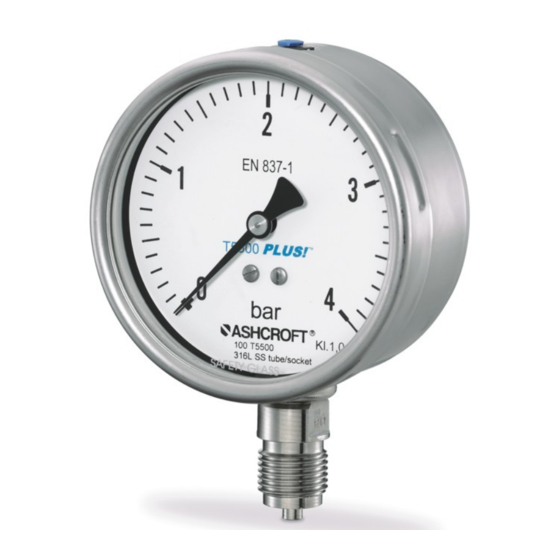
Ashcroft T5500 Instruction And Maintenance Manual
Pressure gauge
Hide thumbs
Also See for T5500:
- Installation and maintenance instruction (6 pages) ,
- Installation and maintenance instructions (5 pages)
Table of Contents
Advertisement
Quick Links
Installation and Maintenance
Instruction Manual
Bourdon tube pressure gauge, model T5500 and T6500
for explosion risk areas pursuant to Directive 94/9/EC (ATEX)
In the following configuration:
• ###T5500/T6500###ATEX bourdon tube pressure gauge without switching contact
• ###T5500/T6500###I####ATEX bourdon tube pressure gauge with inductive proximity switch
IM-T5500/ATEX-EN-Rev C 02/2016
Page 1 of 21
P/N 095I103-02EN
Advertisement
Table of Contents

Subscribe to Our Youtube Channel
Summary of Contents for Ashcroft T5500
- Page 1 Directive 94/9/EC (ATEX) In the following configuration: • ###T5500/T6500###ATEX bourdon tube pressure gauge without switching contact • ###T5500/T6500###I####ATEX bourdon tube pressure gauge with inductive proximity switch IM-T5500/ATEX-EN-Rev C 02/2016 Page 1 of 21 P/N 095I103-02EN...
-
Page 2: Table Of Contents
Environmental protection............................. 5 Use in explosion risk areas pursuant to Directive 94/9/EC (ATEX) ................5 T5500/T6500 without switching contact ......................5 T5500/T6500 I#### with inductive proximity switch KE##I##0C0H2 ..............5 Technical data ................................6 Labeling on the device ..............................6 Labeling on the device for explosion risk areas (ATEX) .................. -
Page 3: General Remarks
11.3 Disposal ................................. 12 Appendix ................................12 12.1 Data sheet for Bourdon tube pressure gauge T5500/T6500 ................. 12 12.2 Declaration of Conformity for device without switching contact ..............13 12.3 Declaration of Conformity for device with inductive proximity switch ............14 12.4... -
Page 4: Safety
2 Safety 2.1 General sources of hazards Pressure gauges are pressurized parts where failure can result in hazardous situations. The selection of pressure gauge should be made in accordance with the rules set out in EN 837-2. 2.2 Use in accordance with intended purpose The devices are only to be used for the intended purpose as described by the manufacturer. -
Page 5: Safety Equipment
The documentation has been filed with TÜV-Nord-Cert (see declaration of conformity). Labeling: II 2 GD c IIC Tx 3.2 T5500/T6500 I#### with inductive proximity switch KE##I##0C0H2 Area of use: Explosion risk areas Zone 1 and 2, risk from gases Permitted temperatures: The maximum occurring surface temperature of 95 °C was determined with no covering of dust and with no safety factor. -
Page 6: Technical Data
5.1 Labeling on the device for explosion risk areas (ATEX) The label with the marking for explosion risk areas is located on the outside of the housing. Device without switching contacts: ###T5500####ATEX or ###T6500####ATEX Page 6 of 21... -
Page 7: Construction And Function
Erläuter ung, z usätzlich ei n Hi nweis : 6.3.2 Instrument connection The instrument connection is located on the bottom side (T5500 and T6500) or at the back side (T5500) of the pressure gauge and is a threaded connection. 6.3.3 Vent valve... -
Page 8: Accessories
6.3.4 Rear wall / plug with blow-out capability The pressure gauge has a plug capable of blowing out on the rear wall of the housing (Model T5500) or a rear wall capable of blowing out (Model T6500). These act as a safety feature pursuant to EN 837-1 and simultaneously allow for temperature compensation for the housing, via a rubber membrane. -
Page 9: Starting Up
When connecting the device, the pipes must be depressurized. The pressure metering pipe must be laid inclined in such a way that, for example, for measurements of fluids no air pockets can form, and for measurements of gases no water pockets. If the necessary incline is not achieved, then at suitable points water separators or air separators must be installed. -
Page 10: Subsequent Relocation Of The Gauge (By The Customer)
Depressurize the pressure metering pipe. Open the bayonet ring and remove ring and window. Hold the pointer in place while turning the screw, until the pointer (after releasing again) has the correct position. Close the case again and pay attention to correct fit of window, gasket and bayonet ring. -
Page 11: Check On Function, And Recalibration
When undertaking servicing work on the device, the pressure lines must be depressurized and the plant secured against being switched on again. 9.2 Check on function, and recalibration The check on function and recalibration is carried out at regular intervals, depending on the application. The precise testing cycles should be adjusted in line with the operating conditions and ambient conditions. -
Page 12: Faults
Please help to protect the environment and dispose of or recycle the devices and components used in accordance with the applicable regulations. 12 Appendix 12.1 Data sheet for Bourdon tube pressure gauge T5500/T6500 Detailed data sheet is available from supplier’s website (see 1.6 Manufacturer’s address, customer services) This table refers to specific documents:... - Page 13 12.2 Declaration of Conformity for device without switching contact Page 13 of 21...
- Page 14 12.3 Declaration of Conformity for device with inductive proximity switch Page 14 of 21...
- Page 15 12.4 EU design type test certification (dusts) for inductive proximity switches of types SJ KE##I##0C0H2 Page 15 of 21...
- Page 16 Page 16 of 21...
- Page 17 Page 17 of 21...
- Page 18 Page 18 of 21...
- Page 19 Page 19 of 21...
- Page 20 Page 20 of 21...
- Page 21 Page 21 of 21...















Need help?
Do you have a question about the T5500 and is the answer not in the manual?
Questions and answers